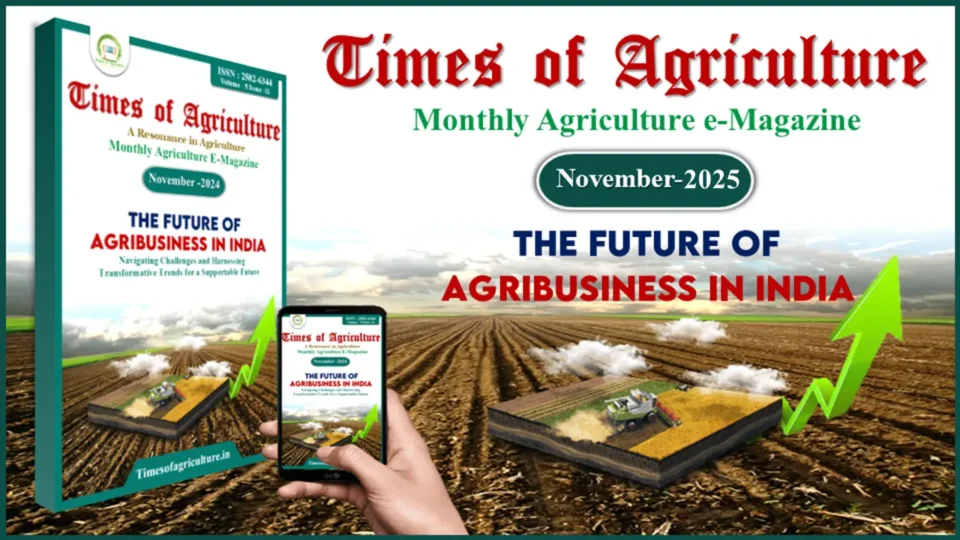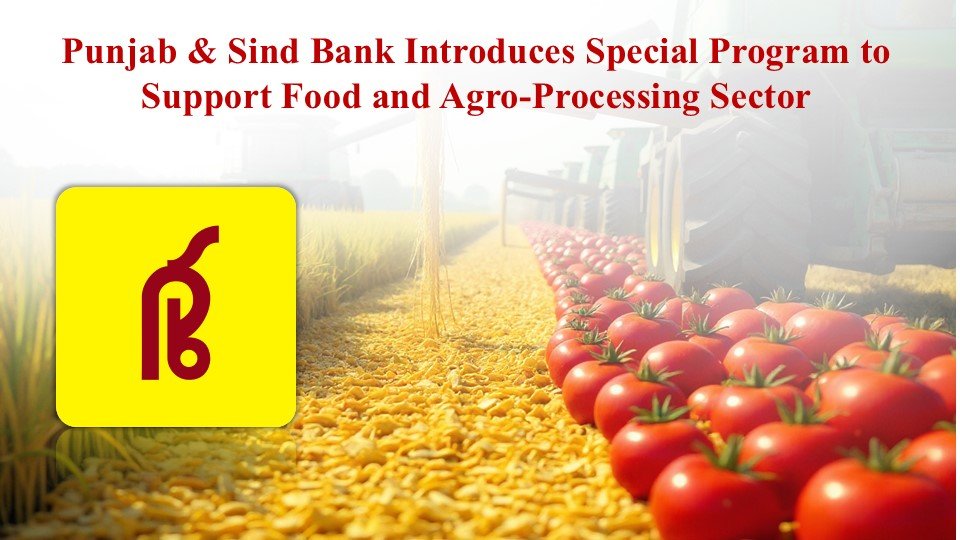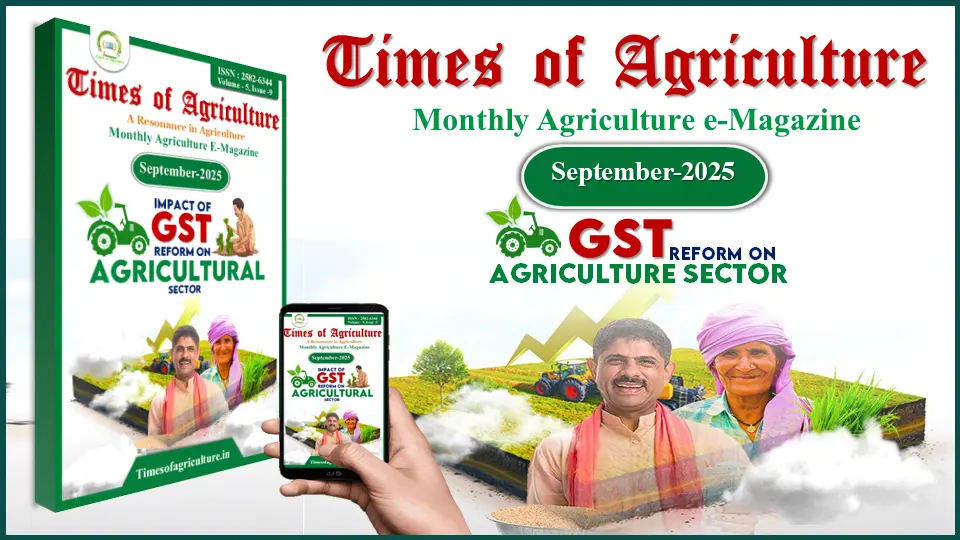In humanity’s lexicon, the word Cattle is an umbrella term referring to a range of animals belonging to the genus Bos. These include Cows, Bulls, Oxen, or calves. They are the most commonly domesticated mammals abreast chickens.
From the inception of civilization, Indians have flourished from the domestication of cattle, utilizing them for milk, meat, dung, and even urine. Therefore, Indian cattle breeds have played and continue to play a vital role in the lives of Indian people. They are closely integrated with our culture and daily routines and possess religious significance. These characteristics are the reason for the importance of cattle breeds in the Indian community. Therefore let us explore the astounding world of Indian cattle breeds:- the pillars of India’s dairy industry and the most reliable coachmen of the country’s agriculture sector.
How Many Types of Cows in India?
The diversity among the types of cows in India is almost similar to her regional and cultural diversity. According to the latest findings, the country has around 50 cattle breeds including dairy, draught, dual purpose, and buffalo. These Indian cattle breeds are from various parts of the country and possess a high degree of variation in their characteristics.
Classification of Indian Cattle Breeds
The types of cows in India are classified mainly on the purpose for which they are reared. The classification of Indian cattle breeds is as follows.
Based on the above classification, it is evident that the types of cow breeds in India are
- Dairy or milch breeds
- Drought breeds
- Dual purpose breeds
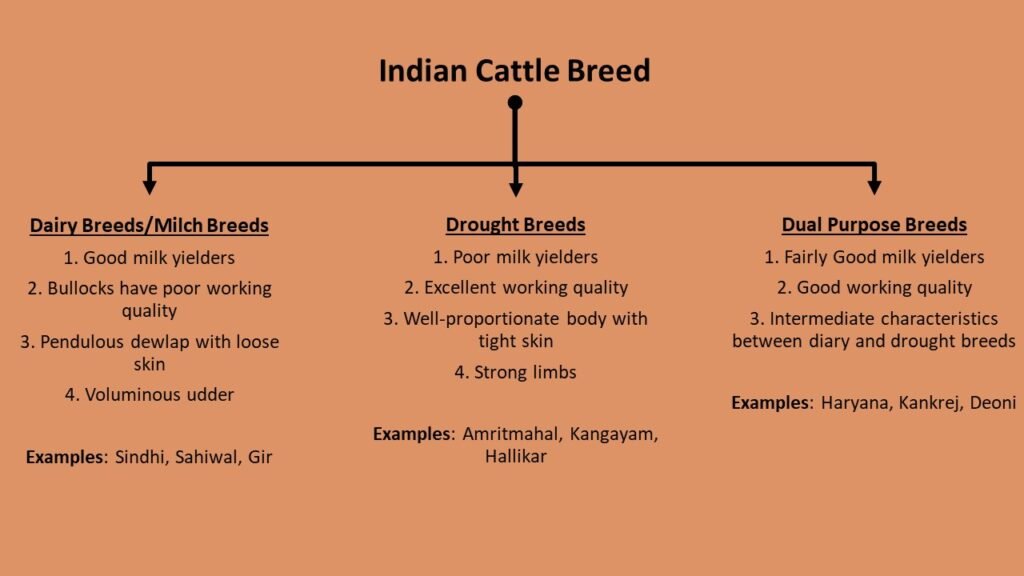
Now we can explore a list of Indian cattle breeds
Read More:
- 25 Profitable Agriculture Business Ideas with Low Investment
- Vertical Farming in India: Setup, Advantage, Suitable Crops
Best Dairy Breeds of Cattle in India
Diary or milch breeds are cattle with a heavy milking capacity of 1500-2000 kg per lactation but poor working capabilities. The most important milch breeds of cattle in India are
1. Sahiwal
| Origin | Montgomery district in Pakistan |
| Synonyms | Montgomery, Lola, Multani, Teli |
| Lactation Period | 300 days |
| Milk Yield | 2725-3125 kg per lactation |
- Among the types of cows in India, Sahiwal is an important Indian milch breed of cattle.
- The color is reddish dun or pale red, often mixed with white patches.
- Horns are short and stumpy, measuring about 3 inches.
- They possess large and heavy dewlap and massive hump (males). The sheath is also pendulous in males.
- The tail is long and fine, with a black switch almost reaching the ground.
- This Indian cattle breed is also involved in developing a cattle breed called the Jamaica Hope.
- Sahiwal is considered the best Indian dairy breed.

2. Red Sindhi
| Origin | Karachi (Pakistan) |
| Synonymous | Red Karachi and Sindhi |
| Lactation period | 296 days |
| Milk Yield | 1100-2600 kg |
- Among the types of cow breeds in India, Red Sindhi is the most economical milk producer.
- The color is red with dark red to light shades along with stripes of stripes of white.
- Hornes emerge laterally and curve upward and are thick at the base.
- Hump is well-developed in males.
- Udder is pendulous and capacious.
- Red Sindhi has a dark-colored muzzle, which is contradictory to Sahiwal’s light-colored muzzle.
- Age at first calving is 39-50 months and the inter-calving period from 425-540 days.
- This Indian milch breed of cattle has high adaptability to varying climatic conditions and high resistance to common cattle diseases.
- These types of cows in India are also extensively used in cross-breeding programs.

3. Gir
| Origin | Gir forest in Gujarat |
| Synonymous | Decan, Gujarati, Kathiawari, Surati |
| Lactation Period | 326 days |
| Milk Yield | 1200-1800 kg |
- This Indian cattle breed has white-colored skin with dark-red or chocolate-brown patches. However, most of the Gir animals found today are purely red.
- They possess a broad convex forehead.
- Long and pendulous ears with a notch at the top are folded like a leaf.
- Horns are peculiarly curved with a lot of internal rotations giving them a ‘half-moon’ appearance.
- The tail is whip-like with adequate length.
- This Indian cattle breed has been exported to other parts of the world like Brazil and the USA.
- Indu-Brasil is a new breed developed in Brazil by the crossing of Gir and Kankrej.
- Age at first calving is 45-54 months and the inter-calving period is from 515-600 days.

These are the most important types of cows in India used for Dairy purposes. Now let’s look at a list of Indian cattle breeds used for Drought purposes.
Best Drought Breeds of Cattle in India
These are the types of cows in India that are used for farm labor and transportation purposes. The general characteristics of these types of cows in India are
- Proportioned body
- Long barrel
- Tight sheath
- Tight skin
- Fast gait
- Alertness
The different types of cows in India used for drought purposes are
1. Amrit Mahal
Origin: Hassan, Chikmagalur, and Chitradurga district of Karnataka.
- These Indian cattle breeds are grey but have a white to near-black shade.
- The head is long. The forehead is narrow bulging out with a furrow in the middle.
- The horns are long.
- The Maharajas of Mysore had developed large farms called Kavals for developing this Indian cattle breed.
- They have a close resemblance to the Hallikar breed.
- Famous draught breed of Indian cattle known for its power and endurance.
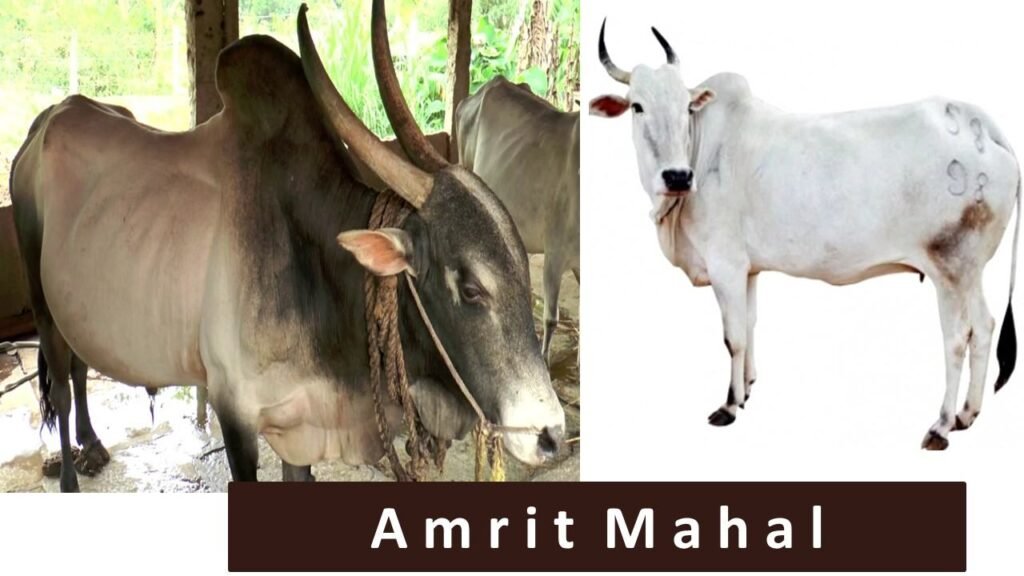
2. Hallikar
Origin: Former princely state of Vijayanagaram, presently part of Karnataka.
- This Indian cattle breed is regarded as one of the best draught breeds in South India.
- They are grey to dark grey.
- Noticeable forehead with a furrow in the middle.
- Compact, muscular, and medium-sized animal.
- Possess a long coffin-shaped face.
- Long horns emerge in proximity to each other near the top of the poll.
- The body is muscular and the legs are strong.
- These types of cows in India are known for their drought capacity and their trotting ability.
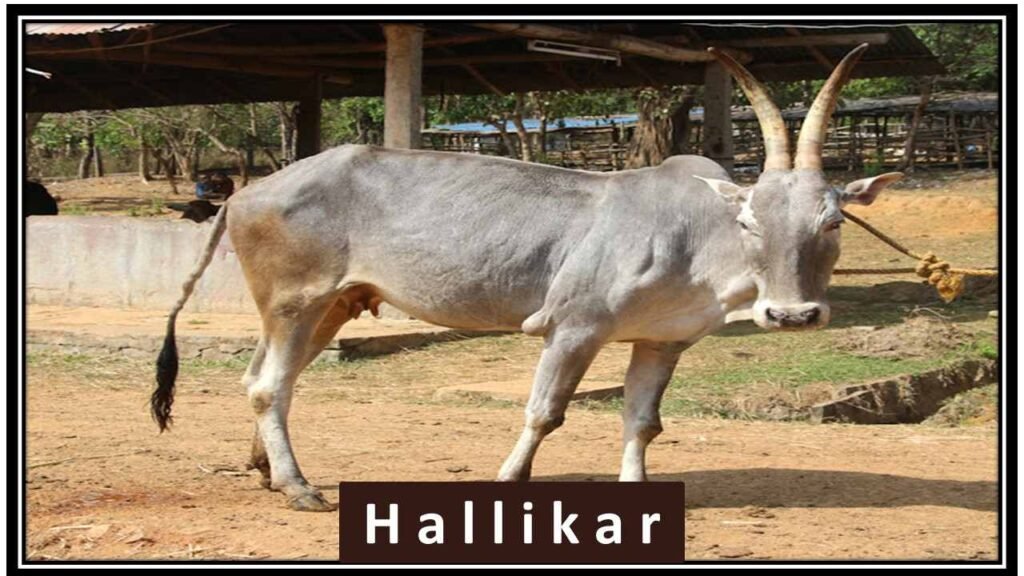
3. Khillari
Origin: Sholapur and Sitapur districts of Maharashtra.
- Fast and powerful draught breed of cattle.
- Greyish white in color.
- They have long faces with bulged foreheads. The face is coffin-shaped.
- Long pointed horns that curve backward initially and then proceed to turn forward.
- Quick gait.
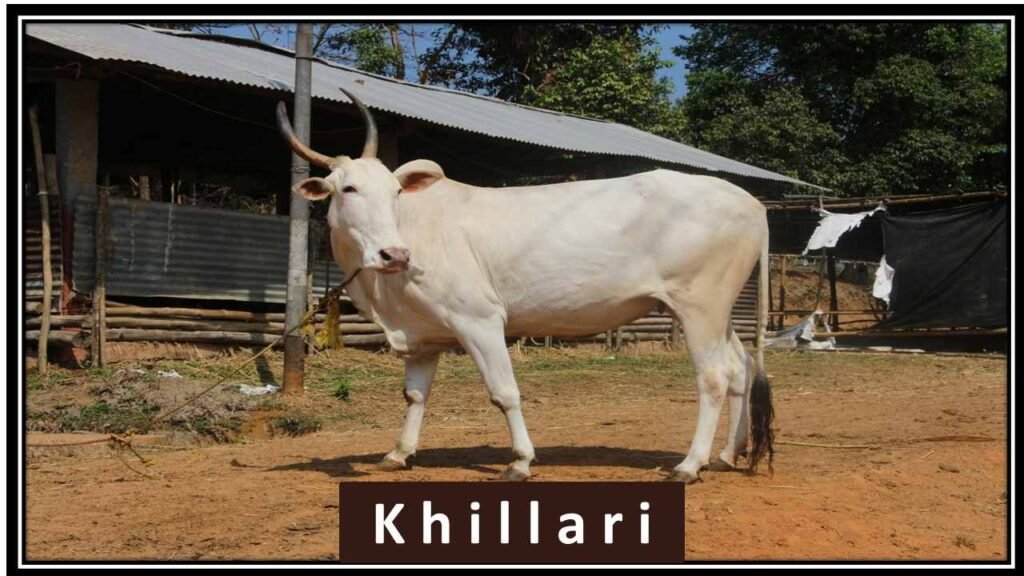
4. Kangayam
Origin: Kangayam, Perunthurai, and Bhavani taluks of Tamil Nadu.
- The calves are red at birth and later turn grey in about six months.
- These types of cows in India are short with stout legs and strong hooves.
- The horns are long, pointy, spread apart, and curve backward.
- They have a thin dewlap and well-tucked-up sheath.
- Ears are erect and pointed.
- Their eyes have black rings around them.
- The Average milk yield is 600-700 kg per lactation.
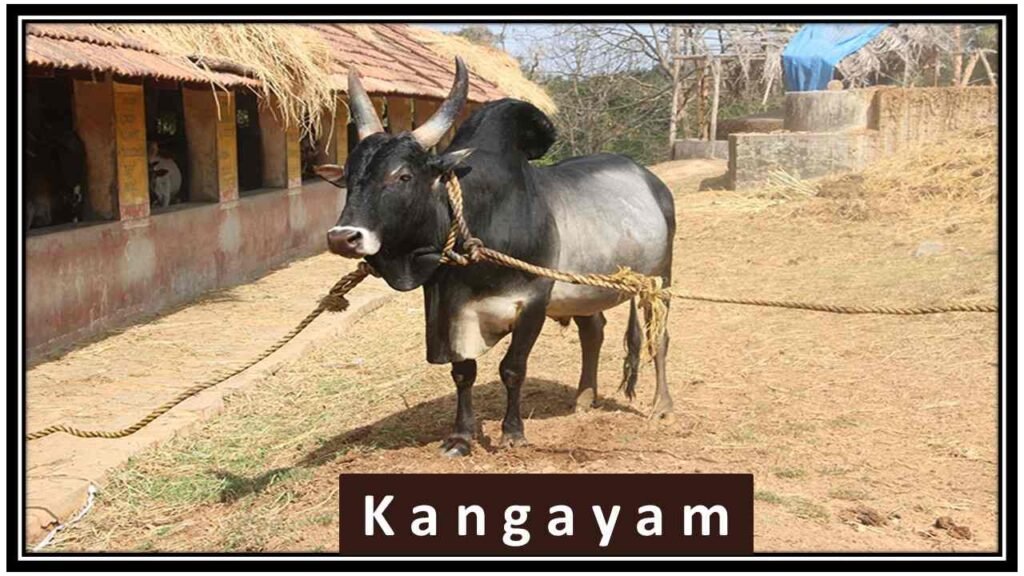
5. Vechur
Origin: Vechur in Kottayam district of Kerala.
- Smallest Indian cattle breed.
- They have different colored body coats with colors like light red, black, white, or grey.
- These types of cows in India possess long narrow faces and horizontal ears.
- Small and thin horns.
- Their length is about 124 cm and their height is below 90 cm. The average weight is about 150 kg.
- Albeit their short stature, they have high disease resistance and great tolerance to hot humid climates.
- Short legs, long tail, small dewlap, and tucked-up sheath.
- Average milk yield of 2-3 kg per day.
- Milk has a high fat content of about 4.7-5.3%.
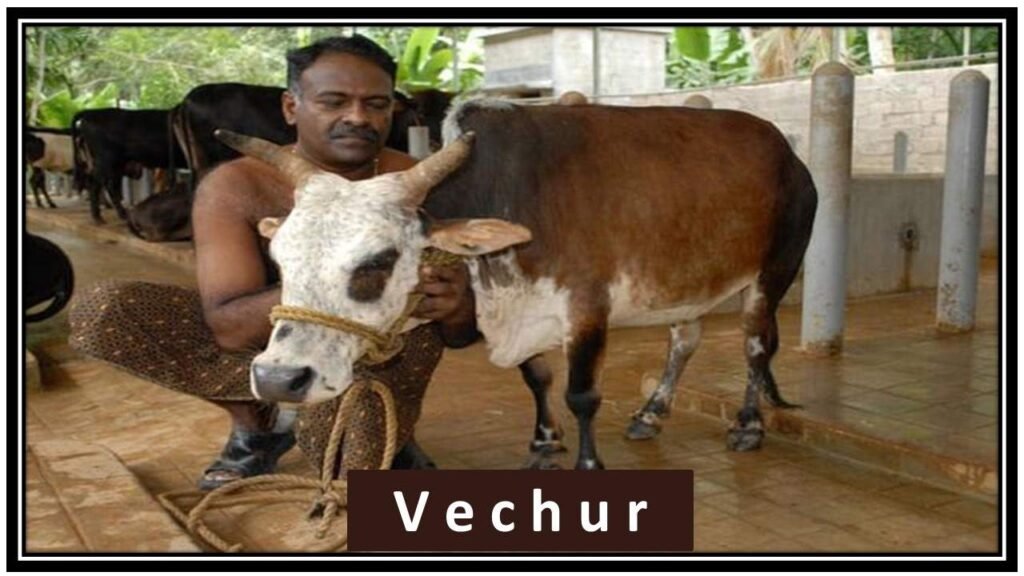
6. Umblacherry
Origin: Tanjore, Nagapatnam district of Tamil Nadu.
- Skin is grey with characteristic white markings on the face and legs.
- Carves are red or brown colored but change to grey in about 6 months.
- Hornes are small and outwardly curved.
- They are small and swift animals.
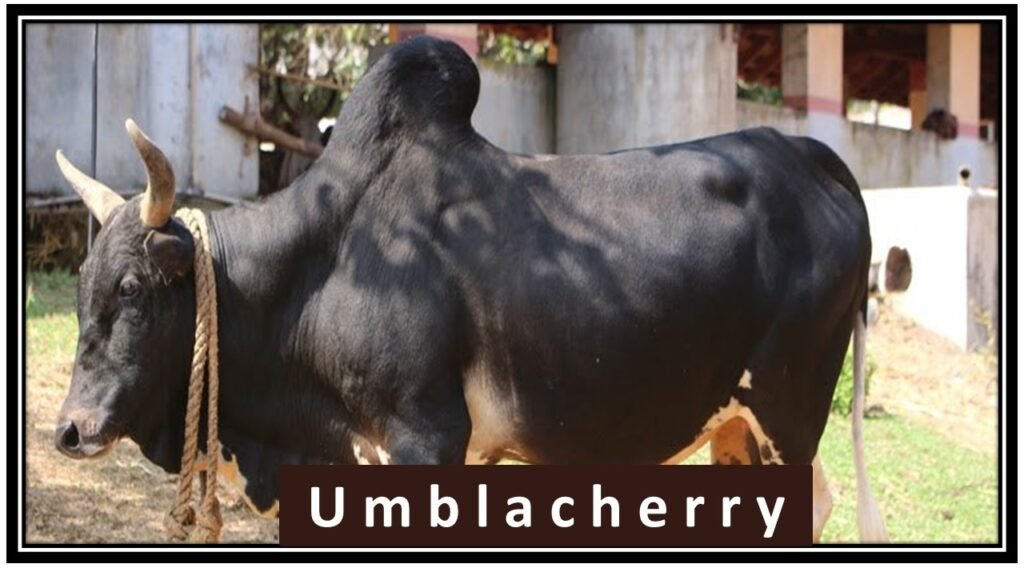
7. Bargur
Origin: Bargur Hills of Erode district of Tamil Nadu.
- These types of cows in India are brown-colored with extensive white markings throughout the body.
- They are compact and medium in size.
- The horns are long and pointy and are close to the base.
- Tucked up sheath.
- Thin and bony limbs.
- This Indian cattle breed is renowned for its speed and endurance.

That sums up the list of Indian cattle breeds used for drought purposes. Next is a list of different types of cows in India used for both dairy and drought purposes.
Read More:
Best Dual Purpose Breeds of Cattle in India.
These are the types of cows in India that can be used for drought purposes and can provide surplus quantities of milk. Their milking potential is an intermediary between milch and draught breeds. Their average milk yield is in the range of 1200-1500 kg per lactation.
The major dual-purpose cattle breeds in India are
1. Ongole
| Origin | Ongole taluk in Andhra Pradesh |
| Synonyms | Nellore |
| Milk Yield | 1000 kg per lactation |
| Age at first calving | 30-45 months |
- They are an important dual-purpose breed of Andhra Pradesh.
- Large heavy animals.
- These Indian cattle breeds possess a glossy-white coat color.
- These cattle breeds possess great muscularity.
- The horns are short, stumpy, and blunt and grow outwards. They are thick at the base.
- The hump is well-developed and the dewlap is fan-shaped.
- They have also been exported to Brazil where they are called Nellore Breed.
- This Indian cattle breed is also involved in developing the Santa Gertrudis breed of the USA.
- They have built a good resistance to diseases and climatic stresses.

2. Deoni
| Origin | Marathwada region of Maharashtra |
| Synonyms | Dongerpati, Dongari, Wannera, Balankya |
| Milk Yield | 630-1230 kg per lactation |
| Age at first calving | 30-51 months |
- Popular dual-purpose breed of Maharastra.
- These types of cows in India have three color varieties
1. The body is fully white
2. Fully white body with a black face
3. Body color is a mixture of black and white - The forehead is prominent and slightly bulged. Ears are dropping.
- The horns are short and blunt with outward and backward bent. They emerge from the sides of the poll.
- Massive and well-developed hump.
- Skin is thick and loosely attached.
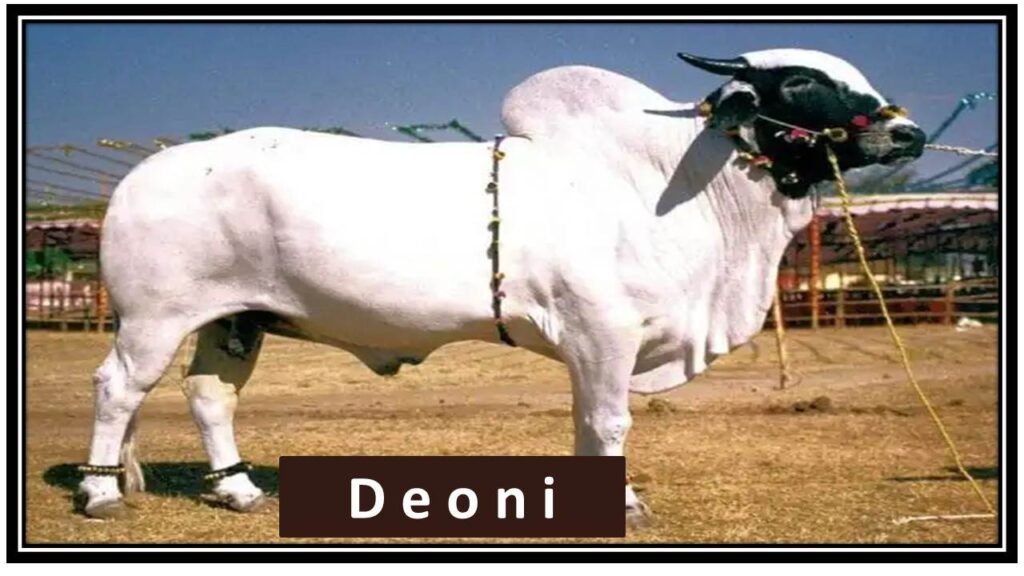
3. Kankrej
| Origin | South-East Rann of Kutch of Gujarat |
| Synonyms | Wadad, Wadhiar, Nagu, Sanehore |
| Milk Yield | 1360 kg per lactation |
- Weighing nearly 500 kg, Kankrej is the largest and the heaviest Indian cattle breed.
- Silver-grey color.
- The face is short with a broad forehead.
- Ears are large pendulous and open.
- Strong lyre-shaped horns. Also considered to be crown-shaped or crescent-shaped.
- The gait is called 1 ¼ paces (Sawai chal) by the breeders because of its peculiar nature.
- These types of cows in India are good milk yielders. They are also fast and powerful animals used for plowing and carting.
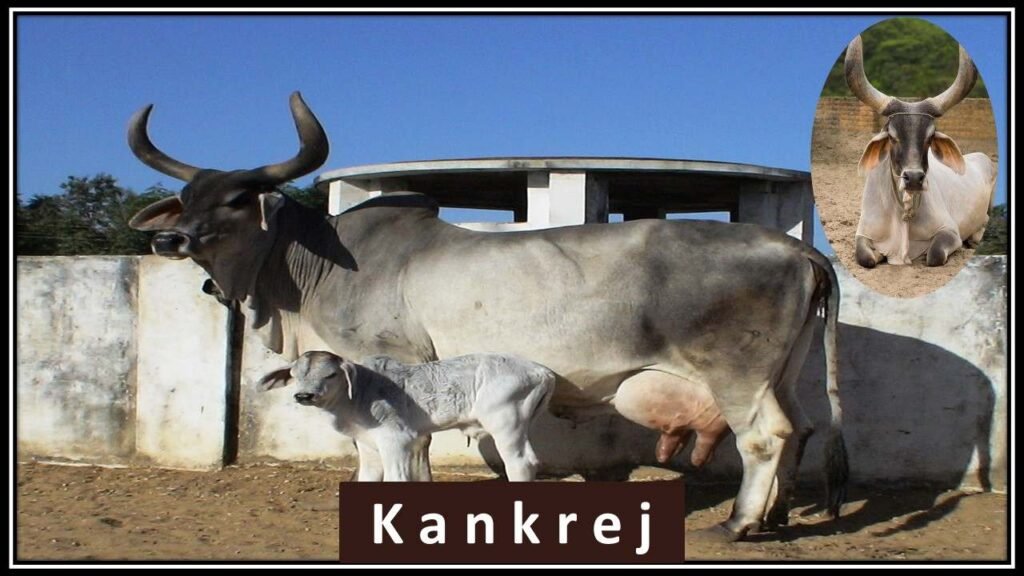
4. Tharparkar
| Origin | Thaparkar district of Pakistan |
| Synonyms | White Sindhi, Grey Sindhi, Thari |
| Milk Yield | 1800-2600 kg per lactation |
| Age at First Calving | 38-42 months |
- White or light grey color.
- Horns are short and thick, set well apart, and curve upward and outward.
- The tail is thin with a black switch.
- The bullocks are suitable for plowing and carting.
- An important dual-purpose Indian cattle breed with a milk yield of around 2000 kg per lactation.
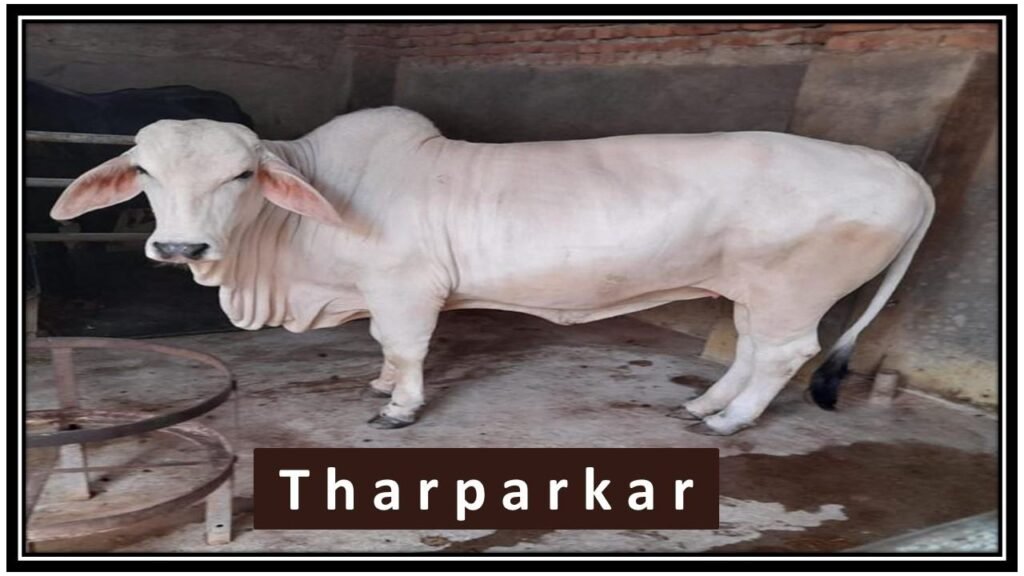
5. Hariana
| Origin | Hissar district of Haryana |
| Synonyms | Haryanvi |
| Milk Yield | 1400 kg per lactation |
| Age at First Calving | 40-60 months |
- White or light-grey color.
- Important dual-purpose breed of north India.
- Compact muscular body.
- Long and narrow face with a flat forehead.
- Small and slightly pendulous ears.
- Short and stumpy horns.
- The naval flap is absent.
- These types of cows in India are good milkers and the bullocks are good workers making them a prominent Indian dual-purpose breed.
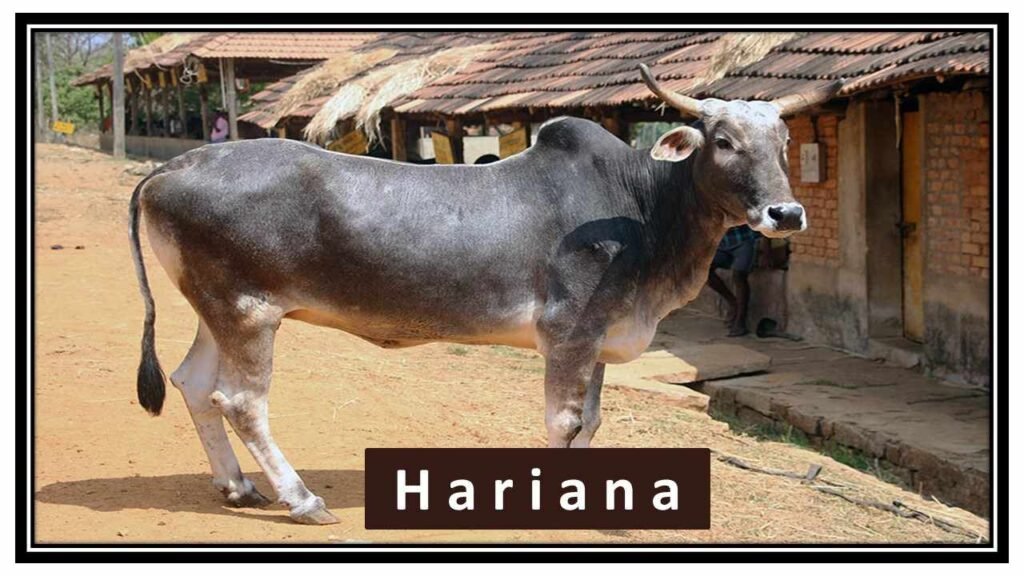
Important Facts About the Types of Cows in India
- Best Indian dairy breed: Sahiwal
- Smallest Indian cattle breed: Vechur
- Heaviest Indian cattle breed: Kankrej
- Most economical milk producer in India: Red Sindhi
- Larget Indian cattle breed: Kankrej
That concludes the list of different types of cows in India. The cattle breeds discussed so far are Indigenous cattle breeds. These are the cattle breeds that are Indigenous to India. Other cattle breeds are imported from other countries for their high milk yields and cross-breeding purposes. They comprise the Exotic Cattle Breeds of India.
Exotic Breeds of Cattle in India
These are different types of cows in India that are brought from European countries mainly for breeding purposes. Their general characteristics are
- High milk producers
- Heavy animals
- Bullocks are poor draught animals
- Humpless
- They are generally docile
The most important exotic breeds of cattle are
1. Jersey
Origin: Jersey islands of the UK
- Smallest dairy cattle breeds.
- Tan to cream color.
- They have a short dished forehead.
- Medium-sized horns.
- Milk yield: 4000-5000 kg per lactation period of 365 days.
- Milk fat content: 5.4%

2. Holstein Friesian
Origin: Holland and Denmark
- Highest milk producer in the world.
- Black and white color.
- Largest dairy breed.
- Milk yield: 6000 to 8000 kg per lactation.
- Milk fat content: 3 to 3.5%
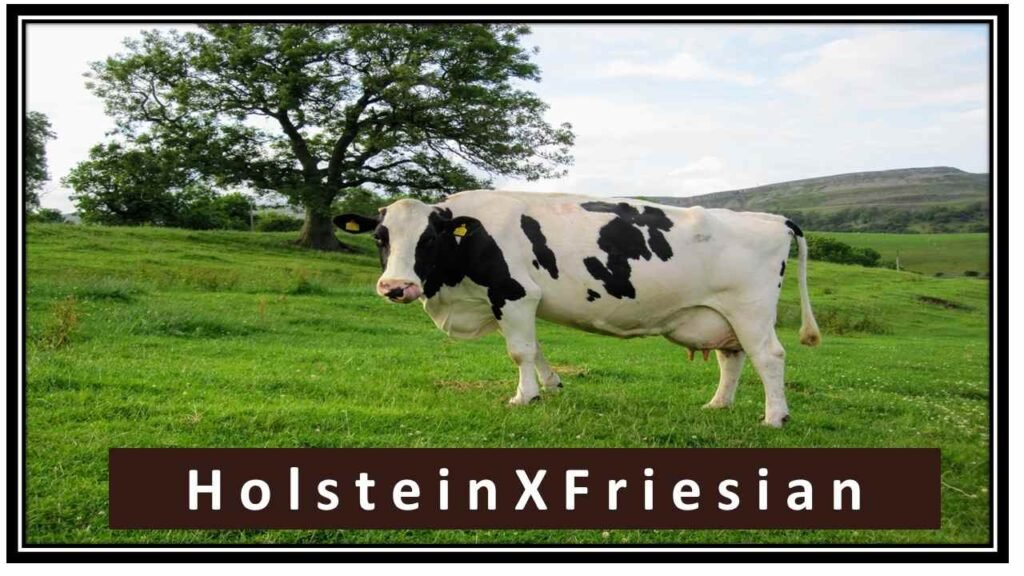
3. Brown Swiss
Origin: Switzerland
- Uniformly brown.
- Second highest milk producer in the world.
- Large and heavy cattle breed.
- Milk production: 6000-7000 kg per lactation.
- Milk fat: 4%
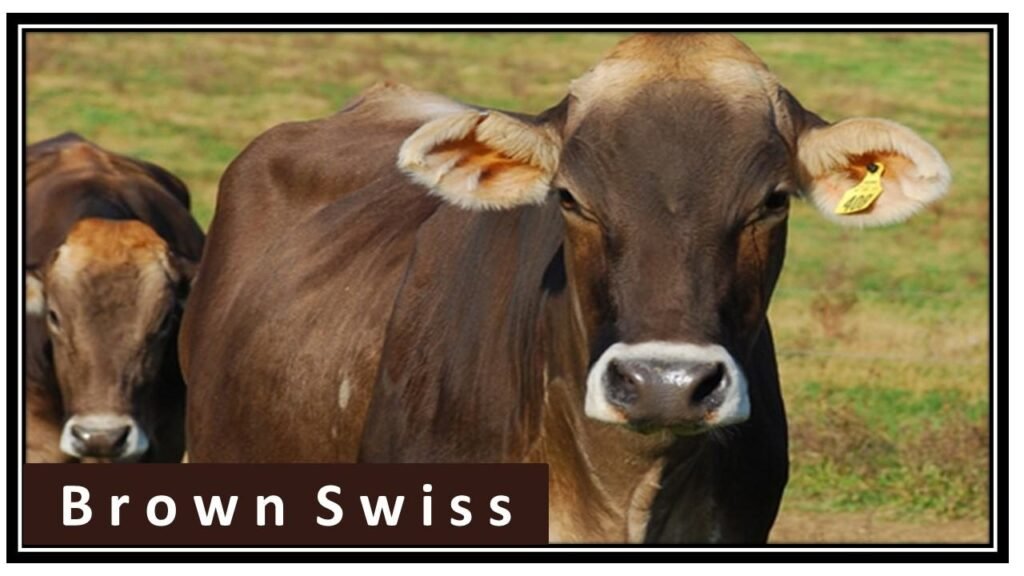
4. Ayrshire
Origin: Scotland
- Third highest milk producer in the world.
- Cherry red and white color.
- Small but pointed horns.
- Milk production: 5000-6000 kg per lactation.
- Milk fat: 4%

5. Guernsey
Origin: United Kingdom
- Fawn with white markings.
- Small pointed horns.
- Fourth highest milk producer in the world.
- Their milk is golden colored.
- Milk production: 4000-5000 kg per lactation.

Read More:
Conclusion
Through this article, we have looked at how many types of cows in India, the different dairy, drought, and dual-purpose cattle breeds.it is evident that there are numerous cattle breeds in India. India is known mainly for her drought cattle breeds rather than dairy breeds. Based on milk yields and other favorable characteristics pertaining to dairy cattle, Indian cattle breeds are comparably subordinate to exotic cattle breeds.
Low milk yield is the biggest problem with Indian cattle breeds. Numerous cross-breeding programs and research are being conducted to improve the production of Indian breeds. These breeding programs involve the crossing with high-yielding exotic breeds and prominent indigenous breeds. The research is heading in the right direction and many high-yielding crossbreds are being developed. We can optimistically hope for the upliftment of the Indian Dairy Industry through these programs but at the same time, we should embrace the versatility and proficiency of our local cattle breeds.

Latest Post
- November Issue 2025- Times of Agriculture Magazine
- Punjab & Sind Bank Introduces Special Program to Support Food and Agro-Processing Sector
- Beyond Classrooms and Gardens: How a Professor Turned His Passion into Purpose
- October Issue 2025- Times of Agriculture Magazine
- Top 10 Pesticide Companies in the World
- September Issue 2025- Times of Agriculture Magazine
- Top 15 Fertilizer Companies in the World
- Top 10 Vegetable Farming Profit Per Acre in India
- August 2025 : Times of Agriculture Magazine (AgriVoltaics Farming)



